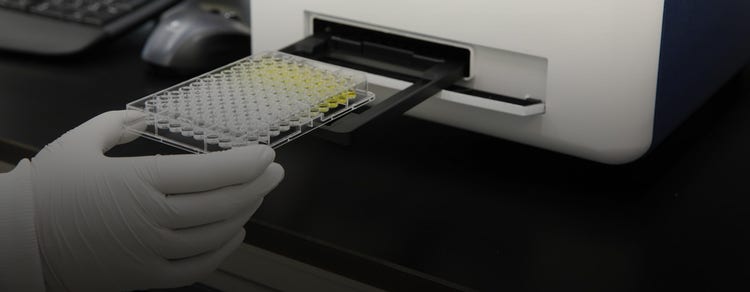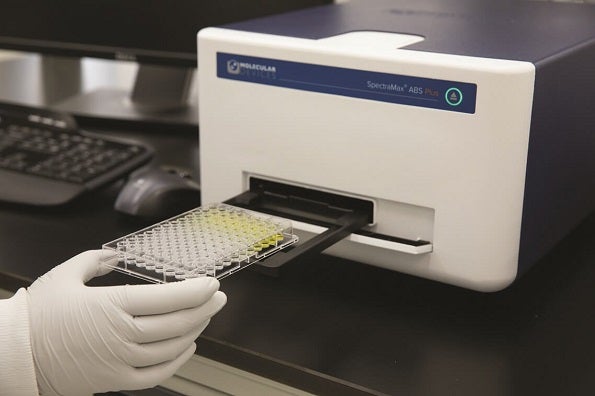
창시에서 코로나19 연구까지 ELISA의 역사
Over the past three decades, ELISA or enzyme-linked immunosorbent assay, has become vital to many areas of research and has shown to have many applications—from detecting food and environmental contaminants to screening for HIV and SARS-CoV-2 (COVID-19) antibodies
ELISA overview
ELISA is a method used to quantitatively detect an antigen (i.e., toxin or foreign substance) within a sample. Most ELISAs are run on microplates, with the bottom of the microplate serving as the solid surface to which an antigen of interest attaches either directly or via an antibody. ELISA microplate readers are typically used by researchers to read and analyze multiple plates simultaneously and obtain accurate ELISA measurements at high throughput.
So how did it all begin? Here, we explore the origin of ELISA and how it has evolved over the years to contribute to some of the most significant scientific breakthroughs of our time.

ELISA timeline
1941 – Albert H. Coons and his colleagues are the first to label antibodies with a fluorescent dye and use it to identify antigens in tissue sections. This method is known today as immunofluorescence.1
1960 – Radioimmunoassay is described in a scientific paper by Rosalyn Sussman and Solomon Berson. However, due to radioactivity posing potential health issues, researchers were in need of a safer alternative.2
1971 – Eva Engvall and Peter Perlman (independently) invent a method that revolutionized medicine called the ELISA test. The method uses antibodies to seek out the presence of hormones or viruses.3,4
1976 – Competitive ELISA method, in which a conjugated substrate competes with a protein of interest, is developed and used to detect human choriogonadotropin hormone.5
1977 – Sandwich ELISA method, in which the detection antibody is coated onto the plate surface before the protein of interest is added, is developed and tested on several substrates for proof-of-concept.6
1978 – Indirect ELISA, in which a secondary antibody is added for detection purposes, was developed and used to detect human serum albumin.7
1985 – The ELISA test is the first screening test commonly employed for HIV. It was approved for use on 1985년 3월 2일.9
TODAY – ELISA is used to test for antibodies of SARS-CoV-2 (COVID-19) in response to a global pandemic causing the complete shutdown of multiple countries.

Learn more about the different ELISA techniques, its various applications, and the ELISA kits, plate readers, washers and software needed to conduct a high-throughput ELISA assay.
참고문헌
- Coons, A. H. The beginnings of immunofluorescence. J. Immunol. 87, 499–503 (1961).Coons, A. H. The beginnings of immunofluorescence. J. Immunol. 87, 499–503 (1961).
- Yalow, Rosalyn and Berson, Solomon. “Immunoassay of endogenous plasma insulin in man.” The Journal of Clinical Investigation. 1960;39: 1157–75.Yalow, Rosalyn and Berson, Solomon. “Immunoassay of endogenous plasma insulin in man.” The Journal of Clinical Investigation. 1960;39: 1157–75.
- Perlmann, Peter et al. “Enzyme-linked immunosorbent assay (ELISA) quantitative assay of immunoglobulin G.” Immunochemistry. 1971;8 (9): 871–4.Perlmann, Peter et al. “Enzyme-linked immunosorbent assay (ELISA) quantitative assay of immunoglobulin G.” Immunochemistry. 1971;8 (9): 871–4.
- Schuurs, A. “Immunoassay using antigen—enzyme conjugates.” FEBS Letters. 1971;15 (3): 232–236.Schuurs, A. “Immunoassay using antigen—enzyme conjugates.” FEBS Letters. 1971;15 (3): 232–236.
- Yorde, Donald et al. “Competitive Enzyme-Linked Immunoassay with Use of Soluble Enzyme/Antibody Immune Complexes for Labeling. I. Measurement of Human Choriogonadotropin.” Clin. Chem. 1976;22/8,1372–1377 Yorde, Donald et al. “Competitive Enzyme-Linked Immunoassay with Use of Soluble Enzyme/Antibody Immune Complexes for Labeling. I. Measurement of Human Choriogonadotropin.” Clin. Chem. 1976;22/8,1372–1377
- Kato, K et al. “Use of rabbit antiboty IgG bound onto plain and aminoalkylsilyl glass surface for the enzyme-linked sandwich immunoassay.” J Biochem. 1977 Jul;82(1):261–6.Kato, K et al. “Use of rabbit antiboty IgG bound onto plain and aminoalkylsilyl glass surface for the enzyme-linked sandwich immunoassay.” J Biochem. 1977 Jul;82(1):261–6.
- Lindström, P et al. “IgG autoantibody to human serum albumin studied by the ELISA-technique.” Scand J Immunol. 1978;7(5):419-25.Lindström, P et al. “IgG autoantibody to human serum albumin studied by the ELISA-technique.” Scand J Immunol. 1978;7(5):419-25.
- Czerkinsky, C et al. “A solid-phase enzyme-linked immunospot (ELISPOT) assay for enumeration of specific antibody-secreting cells.” J Immunol Methods. 1983;65 (1–2): 109–121.Czerkinsky, C et al. “A solid-phase enzyme-linked immunospot (ELISPOT) assay for enumeration of specific antibody-secreting cells.” J Immunol Methods. 1983;65 (1–2): 109–121.
- Alexander, Thomas. “Human Immunodeficiency Virus Diagnostic Testing: 30 Years of Evolution.” Clinical and Vaccine Immunology. 2016 Apr;23(4):249-253.Alexander, Thomas. “Human Immunodeficiency Virus Diagnostic Testing: 30 Years of Evolution.” Clinical and Vaccine Immunology. 2016 Apr;23(4):249-253.